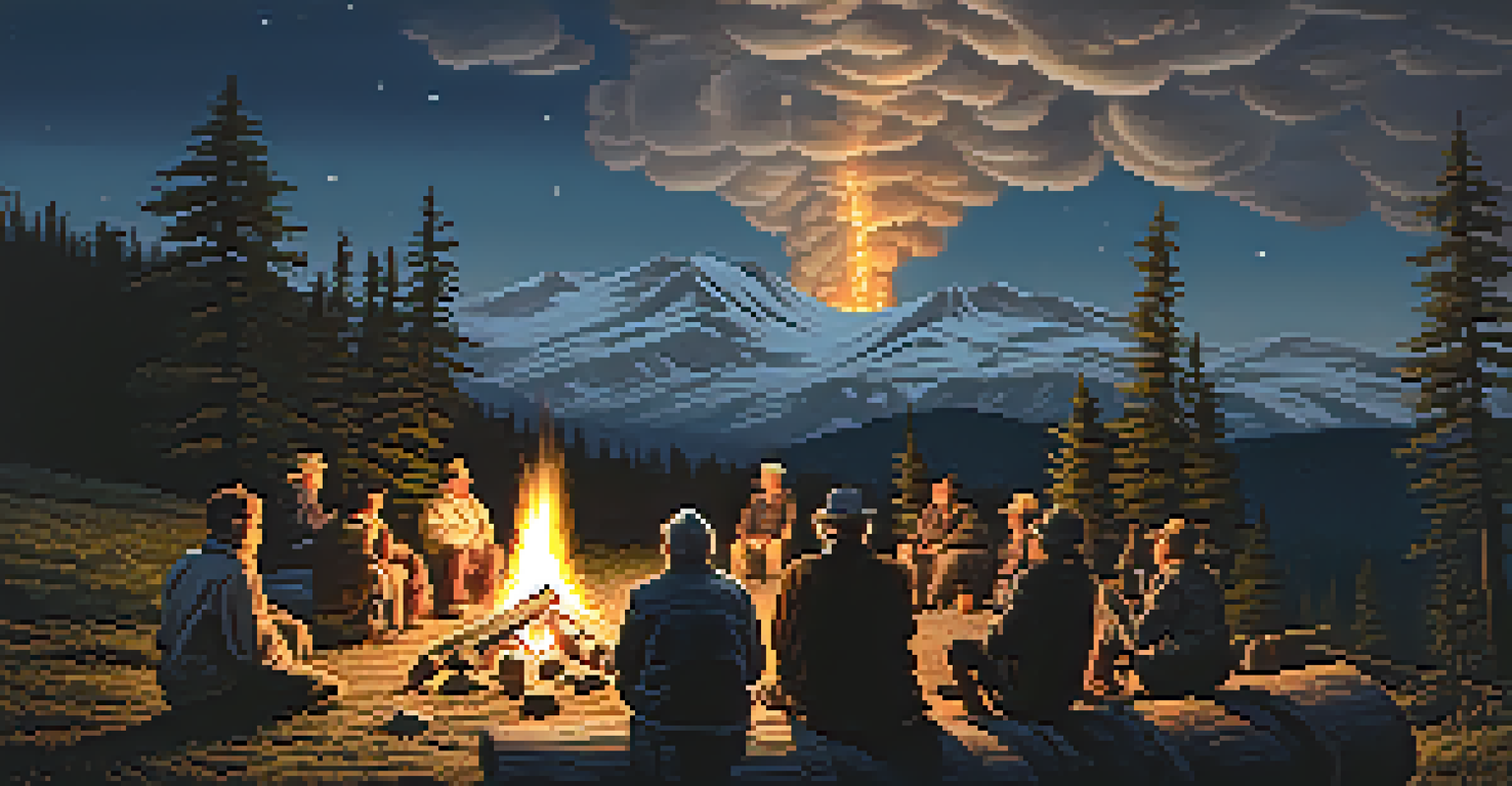Cultural Learning Experiences in Natural Settings

The Importance of Cultural Learning in Nature
Cultural learning experiences in natural settings allow individuals to connect deeply with different cultures. When we immerse ourselves in nature, we don't just see the beauty around us; we also engage with the stories, traditions, and practices of the communities that inhabit those spaces. This type of learning is not confined to classrooms or textbooks; it’s about experiencing culture firsthand in a vibrant, living context.
The earth has music for those who listen.
For instance, visiting a traditional village nestled in the mountains can reveal how the local community interacts with their environment. You might witness the seasonal rituals that celebrate harvests or learn about sustainable practices that have been passed down through generations. These moments create lasting memories that textbooks simply cannot replicate.
Moreover, natural settings often serve as cultural touchstones, where history and tradition intertwine with the landscape. Whether it's a sacred mountain or a river that holds stories of a community's past, these elements provide a rich backdrop for learning. Engaging with nature helps to foster a deeper appreciation for the cultural nuances that shape our world.
Nature as a Classroom for Cultural Understanding
Think of nature as a vast classroom that offers lessons in cultural diversity. Each region has its unique flora, fauna, and geographical features that influence the lifestyles and practices of its inhabitants. By exploring these environments, we gain insights into how culture and nature coalesce, shaping everything from culinary traditions to art forms.

For example, the use of local materials in indigenous architecture reflects a deep understanding of the environment. In places like the Arctic, traditional igloos made from snow showcase how communities adapt to their surroundings. Such examples highlight the innovative ways cultures respond to environmental challenges and resources.
Cultural Learning Through Nature
Experiencing culture in natural settings fosters deeper connections and understanding of diverse traditions and practices.
Furthermore, participating in local ecological practices, such as fishing or farming, allows individuals to experience cultural values in action. These hands-on experiences promote respect and understanding, bridging gaps between different ways of life. When people engage directly with cultural practices in natural settings, they often leave with a greater sense of empathy and appreciation.
Storytelling Through Nature and Culture
Storytelling is a powerful tool in understanding culture, and when combined with nature, it becomes even more impactful. Many cultures have oral traditions that recount their history, beliefs, and values, often using natural elements as key components of their narratives. Engaging with these stories in their natural context brings them to life in a way that enhances understanding.
Cultural learning is about connecting with the world around us, and nature is an essential part of that connection.
Imagine sitting around a campfire under a starlit sky while a local elder shares tales of the land’s spirits and legends. The very ground you sit on becomes part of the story, making it more relatable and immersive. This connection fosters a sense of belonging and respect for the cultural heritage being shared.
Moreover, these stories often emphasize the importance of conservation and stewardship of the environment. By understanding the cultural significance of natural resources, individuals are more likely to appreciate the need for sustainable practices. Thus, storytelling in natural settings not only enriches cultural learning but also promotes a collective responsibility towards the environment.
Experiencing Festivals in Natural Settings
Festivals are vibrant expressions of culture, and many of them take place in natural settings, enhancing the experience. Participating in local celebrations allows individuals to witness firsthand how communities honor their traditions while living in harmony with nature. From harvest festivals to solstice celebrations, these events highlight the bond between culture and the environment.
Take, for instance, a traditional harvest festival held in a lush valley. The celebration is filled with music, dance, and local cuisine that emphasizes the bounty of the land. Such events immerse participants in the cultural identity of the community, creating a sense of connection that goes beyond mere observation.
Challenges in Cultural Learning
Accessibility issues, cultural appropriation, and environmental changes pose significant challenges to engaging with cultural experiences in nature.
Additionally, these festivals often include rituals that reflect the community's respect for nature. By seeing how cultures celebrate their relationship with the earth, attendees can learn valuable lessons about sustainability and the importance of preserving cultural heritage. Ultimately, experiencing festivals in natural settings enriches one’s understanding of both culture and ecology.
Challenges of Cultural Learning in Natural Environments
While cultural learning experiences in natural settings can be enriching, they also come with challenges. Accessibility is a significant issue; not everyone can easily reach remote areas where these cultural experiences often occur. This limitation can prevent many individuals from engaging with diverse cultures in their natural environments.
Moreover, there’s the risk of cultural appropriation, where outsiders might adopt elements of a culture without understanding or respecting its significance. This can lead to misunderstandings and reinforce stereotypes instead of fostering genuine appreciation. It’s essential for learners to approach these experiences with respect and an open mind.
Lastly, environmental changes due to climate change or urban development can threaten traditional practices and cultural sites. As the natural settings that shape these cultures evolve or disappear, so too do the opportunities for learning. Acknowledging these challenges is crucial for ensuring that cultural learning experiences remain viable and respectful.
Promoting Cultural Learning Through Ecotourism
Ecotourism has emerged as a way to promote cultural learning experiences in natural settings while supporting local communities. This approach focuses on responsible travel that emphasizes conservation and cultural engagement. By participating in ecotourism, travelers can immerse themselves in local cultures while also contributing to environmental sustainability.
For example, travelers might stay with indigenous families, learning about their traditions and the natural resources they utilize. These interactions not only enhance the travel experience but also provide economic support to the communities involved. This reciprocal relationship fosters greater respect and understanding between visitors and locals.
Ecotourism's Role in Learning
Ecotourism promotes cultural learning by encouraging responsible travel that supports local communities and fosters environmental sustainability.
Moreover, ecotourism often prioritizes educational components, with guides sharing insights about both cultural practices and ecological systems. This dual focus enriches the learning experience, allowing travelers to appreciate the interconnectedness of culture and nature. By promoting cultural learning through ecotourism, we can help preserve both the environment and cultural heritage.
Future Directions for Cultural Learning in Nature
As we look to the future, the integration of technology with cultural learning experiences in natural settings presents exciting possibilities. Virtual reality, for instance, can offer immersive experiences that allow people to engage with diverse cultures and environments from anywhere in the world. This accessibility could bridge the gap for those unable to travel.
Additionally, educational programs that combine outdoor learning with cultural studies can foster a new generation of culturally aware individuals. Schools and organizations can create curricula that emphasize experiential learning in natural settings, encouraging students to explore and appreciate cultural diversity through direct engagement.

Finally, fostering partnerships between local communities and educational institutions can enhance cultural learning opportunities. By collaborating on programs and initiatives, we can ensure that cultural narratives are preserved and shared authentically. The future of cultural learning in nature lies in creativity, collaboration, and a commitment to understanding the rich tapestry of human experience.